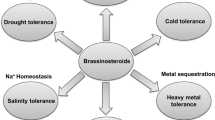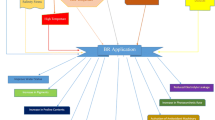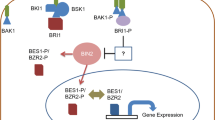Abstract
Brassinosteroids (BRs) are widely used to promote plant growth/development and alleviate environmental stresses’ adverse effects. However, its low stability in the field precludes large-scale application, challenging research, and more stable and cost-effective analogues. The most commonly used is 24-Epibrassinolide (EBL), yet, due to its high production cost, the study of cheaper molecules with similar/higher activity constitutes a priority. In this study, we analyzed, under drought, the effects of EBL and DI-31, a synthetic functional analogue, through a physiological and biochemical approach in Arabidopsis thaliana wild-type plants. Additionally, differential BRs/ABA interactions were detected and further analyzed in abscisic acid (ABA) mutants, assays in stomata with ABA-closure inhibitors, and analysis of ABA-stress-responsive genes expression via qRT-PCR. Similar to EBL, DI-31 induced dose-responsive growth and stomatal closure curve. Compared to EBL, DI-31 induced oxidative burst in a stronger but delayed manner; and increased biomass and foliar area under drought, preventing more effectively the relative water content fall under stress. Although both, EBL and DI-31, enhanced drought-response, the DI-31 action was more effective, durable, and differed in regulating several ABA/stress-response indicators. DI-31/ABA interactions under drought were confirmed in ABA-mutants, where the analogue compromised the activation of ABA-regulated proteins. Moreover, the analogue mediates stomatal closure through paths partially alternative to the ABA-controlled and specifically repressed stress-responsive genes regulated by AREB/ABF transcriptional factors. These findings confirm the DI-31 practical value as growth-promoter and defence-enhancer, with stronger and longer-term activity than EBL, constituting an environmentally-friendly and cost-effective alternative to increase plant fitness under drought, precluding large biomass penalty.






Similar content being viewed by others
References
Ali F, Bano A, Fazal A (2017) Recent methods of drought stress tolerance in plants. Plant Growth Regul 82:363–375. https://doi.org/10.1007/s10725-017-0267-2
Anjum SA, Wang LC, Farooq M et al (2011) Brassinolide application improves the drought tolerance in maize through modulation of enzymatic antioxidants and leaf gas exchange. J Agron Crop Sci 197:177–185. https://doi.org/10.1111/j.1439-037X.2010.00459.x
Bajguz A, Chmur M, Gruszka D (2020) Comprehensive overview of the brassinosteroid biosynthesis pathways: substrates, products, inhibitors, and connections. Front Plant Sci 11:1034. https://doi.org/10.3389/fpls.2020.01034
Bates LS, Waldren RP, Teare ID (1973) Rapid determination of free proline for water-stress studies. Plant Soil 39:205–207. https://doi.org/10.1007/BF00018060
Bradford MM (1976) A rapid and sensitive method for the quantitation of microgram quantities of protein utilizing the principle of protein-dye binding. Anal Biochem 72:248–254. https://doi.org/10.1016/0003-2697(76)90527-3
Cao S, Jiang LI, Xu G (2006) AtGRP7 is involved in the regulation of abscisic acid and stress responses in Arabidopsis. Cell Mol Biol Lett 11:526–535. https://doi.org/10.2478/s11658-006-0042-2
Chai Q, Gan Y, Zhao C et al (2016) Regulated deficit irrigation for crop production under drought stress. A review. Agron Sustain Dev. https://doi.org/10.1007/s13593-015-0338-6
Chaiwanon J, Wang ZY (2015) Spatiotemporal brassinosteroid signaling and antagonism with auxin pattern stem cell dynamics in Arabidopsis roots. Curr Biol 25:1031–1042. https://doi.org/10.1016/j.cub.2015.02.046
Chance B, Maehly AC (1955) Assay of catalases and peroxidases. Methods Enzymol 2:764–775. https://doi.org/10.1016/S0076-6879(55)02300-8
Clouse SD, Hall AF, Langford M et al (1993) Physiological and molecular effects of brassinosteroids on Arabidopsis thaliana. J Plant Growth Regul 12:61–66. https://doi.org/10.1007/BF00193234
Coll MF, Jomarrón RIM, Robaina RCM, Alonso J (1995) Polyhydroxyspirostanones as plant growth regulators. PCT Int Appl CO 7:71–100
Daszkowska-Golec A, Szarejko I (2013) Open or close the gate—stomata action under the control of phytohormones in drought stress conditions. Front Plant Sci 4:138. https://doi.org/10.3389/fpls.2013.00138
Derevyanchuk M, Kretynin S, Iakovenko O et al (2017) Effect of 24-epibrassinolide on Brassica napus alternative respiratory pathway, guard cells movements and phospholipid signaling under salt stress. Steroids 117:16–24. https://doi.org/10.1016/j.steroids.2016.11.006
Di Rienzo JA, Casanoves F, Balzarini MG et al (2018) InfoStat versión 2018
do Vale FXR, Fernandes-Filho EI, Liberato JR (2003) QUANT—a software for plant disease severity assessment. In: 8th International Congress of Plant Pathology. Christchurch, New Zealand, p 105
Doke N (1983) Involvement of superoxide anion generation in the hypersensitive response of potato tuber tissues to infection with an incompatible race of Phytophthora infestans and to the hyphal wall components. Physiol Plant Pathol 23:345–357. https://doi.org/10.1016/0048-4059(83)90019-X
Furio RN, Albornoz PL, Coll Y et al (2019) Effect of natural and synthetic Brassinosteroids on strawberry immune response against Colletotrichum acutatum. Eur J Plant Pathol 153:227–241. https://doi.org/10.1007/s10658-018-1551-3
Gill MB, Cai K, Zhang G, Zeng F (2017) Brassinolide alleviates the drought-induced adverse effects in barley by modulation of enzymatic antioxidants and ultrastructure. Plant Growth Regul 82:447–455. https://doi.org/10.1007/s10725-017-0271-6
Goda H, Shimada Y, Asami T et al (2002) Microarray analysis of brassinosteroid-regulated genes in Arabidopsis. Plant Physiol 130:1319–1334. https://doi.org/10.1104/pp.011254
Gonzalez-Guzman M, Pizzio GA, Antoni R et al (2012) Arabidopsis PYR/PYL/RCAR receptors play a major role in quantitative regulation of stomatal aperture and transcriptional response to abscisic acid. Plant Cell 24:2483–2496. https://doi.org/10.1105/tpc.112.098574
González-Olmedo J, Córdova A, Aragón C et al (2004) Effect of an analogue of brassinosteroid on FHIA-18 plantlets exposed to thermal stress. InfoMusa 14:13–18
Gonzalez-Olmedo J, Coll F (2005) A role for brassinosteroids during acclimatization of pineapple plantlets. Pineapple Newslett Int Soc Hortic Sci 12:17–20
Gudesblat GE, Torres PS, Vojnov AA (2009) Xanthomonas campestris overcomes Arabidopsis stomatal innate immunity through a DSF cell-to-cell signal-regulated virulence factor. Plant Physiol 149:1017–1027. https://doi.org/10.1104/pp.108.126870
Ha YM, Shang Y, Yang D, Nam KH (2018) Brassinosteroid reduces ABA accumulation leading to the inhibition of ABA-induced stomatal closure. Biochem Biophys Res Commun 504:143–148. https://doi.org/10.1016/j.bbrc.2018.08.146
Haubrick LL, Torsethaugen G, Assmann SM (2006) Effect of brassinolide, alone and in concert with abscisic acid, on control of stomatal aperture and potassium currents of Vicia faba guard cell protoplasts. Physiol Plant 128:134–143. https://doi.org/10.1111/J.1399-3054.2006.00708.X
Hoagland D, Arnon D (1950) The water-culture method for growing plants without soil. Circ Calif Agric Exp Stn 347:32
Hodges DM, DeLong JM, Forney CF, Prange RK (1999) Improving the thiobarbituric acid-reactive-substances assay for estimating lipid peroxidation in plant tissues containing anthocyanin and other interfering compounds. Planta 207:604–611. https://doi.org/10.1007/s004250050524
Hussain MA, Fahad S, Sharif R et al (2020) Multifunctional role of brassinosteroid and its analogues in plants. Plant Growth Regul 92:1–16. https://doi.org/10.1007/s10725-020-00647-8
Kagale S, Divi UK, Krochko JE et al (2007) Brassinosteroid confers tolerance in Arabidopsis thaliana and Brassica napus to a range of abiotic stresses. Planta 225:353–364. https://doi.org/10.1007/s00425-006-0361-6
Kar M, Mishra D (1976) Catalase, peroxidase, and polyphenoloxidase activities during rice leaf senescence. Plant Physiol 57:315–319. https://doi.org/10.1104/pp.57.2.315
Kasuga M, Liu Q, Miura S et al (1999) Improving plant drought, salt, and freezing tolerance by gene transfer of a single stress-inducible transcription factor. Nat Biotechnol 17:287–291. https://doi.org/10.1038/7036
Kaur N, Pati PK (2019) Harnessing the potential of brassinosteroids in abiotic stress tolerance in plants. Brassinosteroids: plant growth and development. Springer, Singapore, pp 407–423
Kavitha K, Venkataraman G, Parida A (2008) An oxidative and salinity stress induced peroxisomal ascorbate peroxidase from Avicennia marina: molecular and functional characterization. Plant Physiol Biochem 46:794–804. https://doi.org/10.1016/j.plaphy.2008.05.008
Khokon MAR, Okuma E, Hossain MA et al (2011) Involvement of extracellular oxidative burst in salicylic acid-induced stomatal closure in Arabidopsis. Plant, Cell Environ 34:434–443. https://doi.org/10.1111/j.1365-3040.2010.02253.x
Koressaar T, Remm M (2007) Enhancements and modifications of primer design program Primer3. Bioinformatics 23:1289–1291. https://doi.org/10.1093/bioinformatics/btm091
Kuhn JM, Boisson-Dernier A, Dizon MB et al (2006) The protein phosphatase AtPP2CA negatively regulates abscisic acid signal transduction in arabidopsis, and effects of abh1 on AtPP2CA mRNA. Plant Physiol 140:127–139. https://doi.org/10.1104/pp.105.070318
Kvasnica M, Buchtova K, Budesinsky M et al (2019) Synthesis, characterization and antiproliferative activity of seco analogues of brassinosteroids. Steroids 146:1–13. https://doi.org/10.1016/j.steroids.2019.03.004
Kwak JM, Mori IC, Pei ZM et al (2003) NADPH oxidase AtrbohD and AtrbohF genes function in ROS-dependent ABA signaling in arabidopsis. EMBO J 22:2623–2633. https://doi.org/10.1093/emboj/cdg277
Li X (2012) Improved pyrogallol autoxidation method: a reliable and cheap superoxide-scavenging assay suitable for all antioxidants. J Agric Food Chem 60:6418–6424. https://doi.org/10.1021/jf204970r
Li S, Zheng H, Lin L et al (2020) Roles of brassinosteroids in plant growth and abiotic stress response. Plant Growth Regul. https://doi.org/10.1007/s10725-020-00672-7
Lima JV, Lobato AKS (2017) Brassinosteroids improve photosystem II efficiency, gas exchange, antioxidant enzymes and growth of cowpea plants exposed to water deficit. Physiol Mol Biol Plants 23:59–72. https://doi.org/10.1007/s12298-016-0410-y
Liu P, Ding Y, Liu H et al (2010) Toxic effects of 1-methyl-3-octylimidazolium bromide on the wheat seedlings. J Environ Sci 22:1974–1979. https://doi.org/10.1016/S1001-0742(09)60348-X
Liu J, Zhang D, Sun X et al (2017) Structure-activity relationship of brassinosteroids and their agricultural practical usages. Steroids 124:1–17. https://doi.org/10.1016/j.steroids.2017.05.005
Livak KJ, Schmittgen TD (2001) Analysis of relative gene expression data using real-time quantitative PCR and the 2 C T method. Methods 25:402–408. https://doi.org/10.1006/meth.2001.1262
Mazorra LM, Núñez M, Hechavarria M et al (2002) Influence of brassinosteroids on antioxidant enzymes activity in tomato under different temperatures. Biol Plant 45:593–596. https://doi.org/10.1023/A:1022390917656
Mazorra LM, Núñez M, Nápoles MCC et al (2004) Effects of structural analogs of brassinosteroids on the recovery of growth inhibition by a specific brassinosteroid biosynthesis inhibitor. Plant Growth Regul 44:183–185. https://doi.org/10.1023/b:grow.0000049412.30708.d3
Moreno-Castillo E, Ramírez-Echemendía DP, Hernández-Campoalegre G et al (2018) In silico identification of new potentially active brassinosteroid analogues. Steroids 138:35–42. https://doi.org/10.1016/j.steroids.2018.06.009
Murasnige T, Skoog F (1962) A revised medium for rapid growth and bio agsays with tohaoco tissue cultures. Physiol Plant 15:473–497. https://doi.org/10.1111/j.1399-3054.1962.tb08052.x
Müssig C (2005) Brassinosteroid-promoted growth. Plant Biol 7:110–117. https://doi.org/10.1055/s-2005-837493
Müssig C, Fischer S, Altmann T (2002) Brassinosteroid-regulated gene expression. Plant Physiol 129:1241–1251. https://doi.org/10.1104/pp.011003
Müssig C, Shin GH, Altmann T (2003) Brassinosteroids promote root growth in Arabidopsis. Plant Physiol 133:1261–1271. https://doi.org/10.1104/pp.103.028662
Nakano Y, Asada K (1987) Purification of ascorbate peroxidase in spinach chloroplasts; its inactivation in ascorbate-depleted medium and reactivation by monodehydroascorbate radical. Plant Cell Physiol 28:131–140. https://doi.org/10.1093/oxfordjournals.pcp.a077268
Nemhauser JL, Hong F, Chory J (2006) Different plant hormones regulate similar processes through largely nonoverlapping transcriptional responses. Cell 126:467–475. https://doi.org/10.1016/J.CELL.2006.05.050
Nolan TM, Vukašinović N, Liu D et al (2020) Brassinosteroids: multidimensional regulators of plant growth, development, and stress responses. Plant Cell 32:298–318. https://doi.org/10.1105/tpc.19.00335
Núñez M, Mazzafera P, Antonio M, Zullo T (2003) Influence of a brassinosteroid analogue on antioxidant enzymes in rice grown in culture medium with NaCl. Springer 47:67–70. https://doi.org/10.1023/A:1027380831429
Pérez-Davison G, Restrepo Manrique R, Serrano Gómez M et al (2002) Efectos ecotoxicológicos de un brasinoesteroide en bioindicadores de aguas dulces. Acta Farm Bonaer 21(1):13–20
Porra RJ (2002) The chequered history of the development and use of simultaneous equations for the accurate determination of chlorophylls a and b. Photosynth Res 73:149–156. https://doi.org/10.1023/A:1020470224740
Riemann B (1978) Carotenoid interference in the spectrophotometry determination of chlorophyll degradation products from natural populations of phytoplankton. Limnol Oceanogr 23:1059–1066. https://doi.org/10.4319/lo.1978.23.5.1059
Rio D, Ares M, Hannon G, Nilsen T (2010) Purification of RNA using TRIzol (TRI reagent). Cold Spring Harb Protoc. https://doi.org/10.1101/pdb.prot5439
Rubio S, Rodrigues A, Saez A et al (2009) Triple loss of function of protein phosphatases type 2C leads to partial constitutive response to endogenous abscisic acid. Plant Physiol 150:1345–1355. https://doi.org/10.1104/pp.109.137174
Ruiz-Sola MÁ, Rodríguez-Concepción M (2012) Carotenoid biosynthesis in Arabidopsis: a colorful pathway. Arab B 10:e0158. https://doi.org/10.1199/tab.0158
Ryu H, Cho H, Bae W, Hwang I (2014) Control of early seedling development by BES1/TPL/HDA19-mediated epigenetic regulation of ABI3. Nat Commun 5:1–11. https://doi.org/10.1038/ncomms5138
Sahni S, Prasad BD, Liu Q et al (2016) Overexpression of the brassinosteroid biosynthetic gene DWF4 in Brassica napus simultaneously increases seed yield and stress tolerance. Sci Rep 6:1–14. https://doi.org/10.1038/srep28298
Sajedi N, Madani H, Naderi A (2011) Effect of microelements and selenium on superoxide dismutase enzyme, malondialdehyde activity and grain yield maize (Zea mays L.) under water deficit stress. Not Bot Horti Agrobot Cluj-Napoca 39:153–159. https://doi.org/10.15835/nbha3925500
Sakai K, Kamuro Y, Takatsuto S et al (1999) Plant growth regulating composition comprising epoxycyclohexane derivatives and brassinosteroids as well as method of regulating plant growth comprising the application thereof
Sasse JM (2003) Physiological actions of brassinosteroids: an update. J Plant Growth Regul 22:276–288. https://doi.org/10.1007/s00344-003-0062-3
Schneider CA, Rasband WS, Eliceiri KW (2012) NIH image to ImageJ: 25 years of image analysis. Nat Methods 9:671–675
Seo M, Nambara E, Choi G, Yamaguchi S (2009) Interaction of light and hormone signals in germinating seeds. Plant Mol Biol 69:463–472. https://doi.org/10.1007/S11103-008-9429-Y
Serna M, Hernández F, Coll F et al (2012) Brassinosteroid analogues effects on the yield and quality parameters of greenhouse-grown pepper (Capsicum annuum L.). Plant Growth Regul 68:333–342. https://doi.org/10.1007/s10725-012-9718-y
Serna M, Hernández F, Coll F et al (2013) Effects of brassinosteroid analogues on total phenols, antioxidant activity, sugars, organic acids and yield of field grown endive (Cichorium endivia L.). J Sci Food Agric 93:1765–1771. https://doi.org/10.1002/jsfa.5968
Serna M, Coll Y, Zapata PJ et al (2015) A brassinosteroid analogue prevented the effect of salt stress on ethylene synthesis and polyamines in lettuce plants. Sci Hortic (amsterdam) 185:105–112. https://doi.org/10.1016/j.scienta.2015.01.005
Shang Y, Dai C, Myeong ML et al (2016) BRI1-associated receptor kinase 1 regulates guard cell ABA signaling mediated by open stomata 1 in Arabidopsis. Mol Plant 9:447–460. https://doi.org/10.1016/j.molp.2015.12.014
Sharma P, Jha AB, Dubey RS, Pessarakli M (2012) Reactive oxygen species, oxidative damage, and antioxidative defense mechanism in plants under stressful conditions. J Bot. https://doi.org/10.1155/2012/217037
Shi K, Li X, Zhang H et al (2015) Guard cell hydrogen peroxide and nitric oxide mediate elevated CO2-induced stomatal movement in tomato. New Phytol 208:342–353. https://doi.org/10.1111/nph.13621
Shinozaki K, Yamaguchi-Shinozaki K (1997) Gene expression and signal transduction in water-stress response’. Plant Physiol 11:327–334
Signorelli S, Monza J (2017) Plant signaling & behavior identification of ∆ 1-pyrroline 5-carboxylate synthase (P5CS) genes involved in the synthesis of proline in Lotus japonicus. Taylor Fr. https://doi.org/10.1080/15592324.2017.1367464
Singh D, Laxmi A (2015) Transcriptional regulation of drought response: a tortuous network of transcriptional factors. Front Plant Sci 6:895. https://doi.org/10.3389/fpls.2015.00895
Souri Z, Karimi N, Farooq MA, Akhtar J (2020) Phytohormonal signaling under abiotic stress. Plant life under changing environment. Elsevier, Amsterdam, pp 397–466
Steber CM, McCourt P (2001) A role for brassinosteroids in germination in Arabidopsis. Plant Physiol 125:763–769. https://doi.org/10.1104/PP.125.2.763
Szekeres M, Németh K, Koncz-Kálmán Z et al (1996) Brassinosteroids rescue the deficiency of CYP90, a cytochrome P450, controlling cell elongation and De-etiolation in Arabidopsis. Cell 85:171–182. https://doi.org/10.1016/S0092-8674(00)81094-6
Takahashi F, Kuromori T, Urano K et al (2020) Drought stress responses and resistance in plants: from cellular responses to long-distance intercellular communication. Front Plant Sci 11:1407. https://doi.org/10.3389/FPLS.2020.556972
Tang J, Han Z, Chai J (2016) Q&A: what are brassinosteroids and how do they act in plants. BMC Biol 14:113. https://doi.org/10.1186/s12915-016-0340-8
Tanveer M, Shahzad B, Sharma A, Khan EA (2019) 24-Epibrassinolide application in plants: an implication for improving drought stress tolerance in plants. Plant Physiol Biochem 135:295–303. https://doi.org/10.1016/j.plaphy.2018.12.013
Tripathy BC, Oelmüller R (2012) Reactive oxygen species generation and signaling in plants. Plant Signal Behav 7:1621–1633. https://doi.org/10.4161/psb.22455
Umezawa T, Sugiyama N, Mizoguchi M et al (2009) Type 2C protein phosphatases directly regulate abscisic acid-activated protein kinases in Arabidopsis. Proc Natl Acad Sci USA 106:17588–17593. https://doi.org/10.1073/pnas.0907095106
Untergasser A, Cutcutache I, Koressaar T et al (2012) Primer3-new capabilities and interfaces. Nucleic Acids Res 40:e115–e115. https://doi.org/10.1093/nar/gks596
Valliyodan B, Nguyen HT (2006) Understanding regulatory networks and engineering for enhanced drought tolerance in plants. Curr Opin Plant Biol 9:189–195. https://doi.org/10.1016/j.pbi.2006.01.019
van Halsema G, Vincent L (2012) Efficiency and productivity terms for water management: a matter of contextual relativism versus general absolutism. Agric Water Manag 108:9–15. https://doi.org/10.1016/j.agwat.2011.05.016
Van Oosten MJ, Costa A, Punzo P et al (2016) Genetics of drought stress tolerance in crop plants. Drought stress tolerance in plants, vol 2: molecular and genetic perspectives. Springer, Berlin, pp 39–70
Vriet C, Russinova E, Reuzeaua C (2012) Boosting crop yields with plant steroids. Plant Cell 24:842–857. https://doi.org/10.1105/tpc.111.094912
Wang H, Tang J, Liu J et al (2018) Abscisic acid signaling inhibits brassinosteroid signaling through dampening the dephosphorylation of BIN2 by ABI1 and ABI2. Mol Plant 11:315–325. https://doi.org/10.1016/j.molp.2017.12.013
Weatherley PE (1950) Studies in the water relations of the cotton plant. I. The field measurement of water deficits in leaves. New Phytol 49:81–97. https://doi.org/10.1111/j.1469-8137.1950.tb05146.x
Xia XJ, Wang YJ, Zhou YH et al (2009) Reactive oxygen species are involved in brassinosteroid-induced stress tolerance in cucumber. Plant Physiol 150:801–814. https://doi.org/10.1104/pp.109.138230
Xia XJ, Gao CJ, Song LX et al (2014) Role of H2O2 dynamics in brassinosteroid-induced stomatal closure and opening in Solanum lycopersicum. Plant, Cell Environ 37:2036–2050. https://doi.org/10.1111/pce.12275
Xue L-W, Du J-B, Yang H et al (2009) Brassinosteroids counteract abscisic acid in germination and growth of Arabidopsis. Z Naturforsch C 64:225–230. https://doi.org/10.1515/znc-2009-3-413
Yang X, Bai Y, Shang J et al (2016) The antagonistic regulation of abscisic acid-inhibited root growth by brassinosteroids is partially mediated via direct suppression of ABSCISIC ACID INSENSITIVE 5 expression by BRASSINAZOLE RESISTANT 1. Plant Cell Environ 39:1994–2003. https://doi.org/10.1111/pce.12763
Yoshida T, Fujita Y, Sayama H et al (2010) AREB1, AREB2, and ABF3 are master transcription factors that cooperatively regulate ABRE-dependent ABA signaling involved in drought stress tolerance and require ABA for full activation. Plant J 61:672–685. https://doi.org/10.1111/j.1365-313X.2009.04092.x
Zhang S, Cai Z, Wang X (2009) The primary signaling outputs of brassinosteroids are regulated by abscisic acid signaling. Proc Natl Acad Sci 106:4543–4548. https://doi.org/10.1073/PNAS.0900349106
Zhang A, Zhang J, Zhang J et al (2011) Nitric oxide mediates brassinosteroid-induced ABA biosynthesis involved in oxidative stress tolerance in maize leaves. Plant Cell Physiol 52:181–192. https://doi.org/10.1093/PCP/PCQ187
Acknowledgements
This work was supported by a grant from the National Council of Scientific and Technical Research (CONICET) of the Argentine Republic (Res.3224 to LSPB), a Bioplantas Institutional Project (0018 to JLGO), and GrB2/GrB3 EEAOC Grains Program work plans (to EMP). The authors are grateful to Prof Miguel Gonzalez-Guzmán from Molecular and Cellular Plant Biology Institute- Polytechnic University of Valencia for providing pp2ca-1 and SnRK2.6/ost1 seeds. The authors would like to especially thank Dr Christian W. Bachem from the Plant Sciences Department of Wageningen University for his very accurate and creative corrections.
Author information
Authors and Affiliations
Contributions
All authors contributed to the study conception and design. LSP-B designed and performed the experiments, compiled the data and first draft of the manuscript. LT performed the stomata analysis. APC and JLG-O conceived the project; FC-M, EMP and YC-G designed and supervised the experiments. All authors commented on previous versions of the manuscript, read and approved the final manuscript.
Corresponding author
Additional information
Communicated by Kalina Ananieva.
Publisher's Note
Springer Nature remains neutral with regard to jurisdictional claims in published maps and institutional affiliations.
Supplementary Information
Below is the link to the electronic supplementary material.
Rights and permissions
About this article
Cite this article
Pérez-Borroto, L.S., Toum, L., Castagnaro, A.P. et al. Brassinosteroid and brassinosteroid-mimic differentially modulate Arabidopsis thaliana fitness under drought. Plant Growth Regul 95, 33–47 (2021). https://doi.org/10.1007/s10725-021-00722-8
Received:
Accepted:
Published:
Issue Date:
DOI: https://doi.org/10.1007/s10725-021-00722-8




